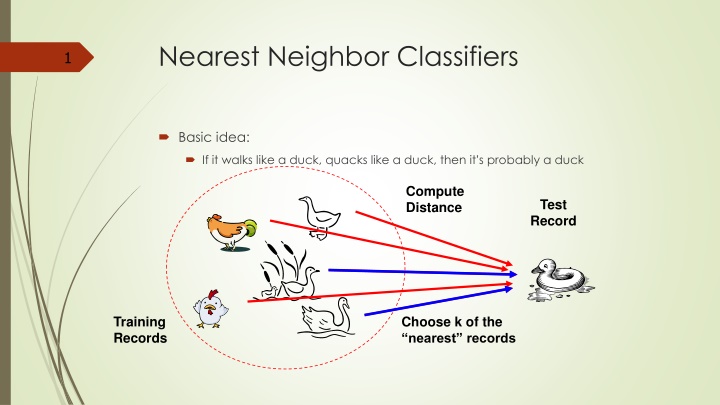
k-Nearest Neighbor (KNN) Classifiers in Machine Learning
Explore the basic concept, lazy algorithm, applications, simplicity, and non-parametric nature of k-Nearest Neighbor (KNN) classifiers in machine learning. Discover how KNN operates without assumptions about the underlying function and uses proximity to classify new data points effectively.
Download Presentation

Please find below an Image/Link to download the presentation.
The content on the website is provided AS IS for your information and personal use only. It may not be sold, licensed, or shared on other websites without obtaining consent from the author. If you encounter any issues during the download, it is possible that the publisher has removed the file from their server.
You are allowed to download the files provided on this website for personal or commercial use, subject to the condition that they are used lawfully. All files are the property of their respective owners.
The content on the website is provided AS IS for your information and personal use only. It may not be sold, licensed, or shared on other websites without obtaining consent from the author.
E N D
Presentation Transcript
Nearest Neighbor Classifiers 1 Basic idea: If it walks like a duck, quacks like a duck, then it s probably a duck Compute Distance Test Record Training Records Choose k of the nearest records
Lazy algorithm 2 k-NN classifiers are lazy learners It does not build models explicitly Unlike eager learners such as decision tree induction and rule-based systems Classifying unknown records are relatively expensive
KNN - Applications 3 Classification and Interpretation legal, medical, news, banking Problem-solving planning, pronunciation Function learning dynamic control Teaching and aiding help desk, user training
KNN 4 KNN is conceptually simple, yet able to solve complex problems Can work with relatively little information Learning is simple (no learning at all!) Memory and CPU cost Feature selection problem Sensitive to representation
KNN 5 KNN is a simple algorithm that stores all available cases and classifies new cases based on a similarity measure
The idea behind the k-Nearest Neighbor algorithm is to build a classification method using no assumptions about the form of the function, y = f(x1, x2, ...xp) that relates the dependent (or response) variable, y, to the independent (or predictor) variables x1, x2, ...xp. The only assumption we make is that it is a smooth function. This is a non- parametric method because it does not involve estimation of parameters in an assumed function form such as the linear form that we encountered in linear regression.
